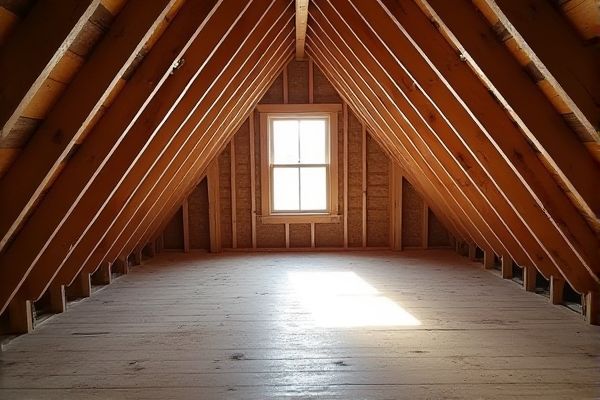
Attic crawlspace offers limited access and storage but is typically smaller and less insulated than the main attic, which provides more space and better ventilation for home energy efficiency. Understanding the differences between your attic crawlspace and main attic can help optimize your home's insulation and maintenance; read on to discover which suits your needs best.
Table of Comparison
| Feature | Attic Crawlspace | Main Attic |
|---|---|---|
| Access | Small, limited space; often requires crawling | Large, walkable space; easy access |
| Purpose | Storage of utilities, limited storage use | Storage, HVAC systems, insulation, and maintenance |
| Ventilation | Minimal ventilation; risk of moisture buildup | Better ventilation; reduces moisture and mold risk |
| Insulation | Limited insulation options due to tight space | Ample space for insulation; improves energy efficiency |
| Maintenance | Difficult due to restricted space | Easy access allows routine inspection and repairs |
| Cost | Lower construction cost; less flexibility | Higher construction and maintenance costs |
| Safety | Higher risk of accidents due to limited maneuverability | Safer, more comfortable access and workspace |
Introduction to Attic Crawlspace and Main Attic
An attic crawlspace is a narrow, low-height area typically used for limited storage or access to HVAC and electrical systems, while the main attic is a larger, more accessible space often designed for extensive storage or potential living area conversion. Insulation and ventilation needs differ between these spaces due to their size and usage, impacting energy efficiency. Understanding the distinctions helps optimize home comfort, maintenance, and structural integrity.
Defining Attic Crawlspace
An attic crawlspace is a smaller, often low-height area within or adjacent to the main attic, primarily designed for access to HVAC systems, insulation, or wiring rather than for storage. Unlike the main attic, which typically offers more spacious and open storage capacity, the crawlspace is confined and less accessible. Understanding the distinction helps optimize your home's insulation and maintenance strategies effectively.
What is a Main Attic?
A main attic is the primary space located directly under the roof of a home, typically used for ventilation, insulation, and sometimes storage, spanning the entire roofline. Unlike a crawlspace attic, which is a smaller, accessible area with limited height for inspection or minor maintenance, a main attic offers more headroom and easier access for significant tasks such as insulation upgrades or HVAC installation. Understanding the main attic's role is crucial for energy efficiency and moisture control in residential buildings.
Structural Differences
An attic crawlspace typically features reduced height and limited access, designed primarily for utility installations or storage, while a main attic offers a full-height space beneath the roof rafters. Structural differences include variations in insulation, ventilation, and framing; crawlspaces use lighter framing and minimal support structures, whereas main attics require robust rafters and joists to support roof loads and potential living space conversion. These distinctions impact load-bearing capacity, airflow management, and thermal efficiency between the two attic types.
Accessibility and Usability
Attic crawlspaces typically have limited accessibility due to low clearance and smaller entry points, making maintenance tasks more challenging. Main attics offer greater usability with higher ceilings and larger access doors, allowing for easier storage and inspection. These factors influence homeowners' decisions when considering insulation improvements or HVAC installations.
Insulation and Energy Efficiency
Insulating the main attic typically provides greater energy efficiency benefits compared to an attic crawlspace due to its larger volume and direct influence on the home's overall thermal envelope. Attic crawlspaces often have limited insulation options and may suffer from air leaks and moisture issues, reducing their energy performance. Properly air sealing and insulating the main attic with materials like spray foam or fiberglass batts significantly decreases heat loss, improving HVAC efficiency and lowering energy bills.
Storage Potential: Crawlspace vs Main Attic
Attic crawlspaces offer limited storage potential due to their low ceiling height and restricted access, making them suitable only for lightweight, infrequently used items. Main attics provide significantly greater storage capacity with easier access and better structural support, allowing you to store larger, heavier objects safely. Maximizing your home's storage efficiency depends on evaluating these spatial differences and your specific storage needs.
Maintenance Challenges
Attic crawlspaces often present more maintenance challenges due to limited accessibility, increasing difficulty in inspecting insulation, wiring, and pest infestations. Main attics typically allow easier access for routine upkeep, enabling more effective ventilation and moisture control. Poor maintenance in either space can lead to structural damage, higher energy costs, and compromised indoor air quality.
Moisture and Ventilation Considerations
Attic crawlspaces often face increased moisture buildup due to limited ventilation compared to main attics, which typically have more comprehensive airflow systems like ridge vents and soffit vents. Poor ventilation in crawlspaces can lead to mold growth and structural damage, whereas properly ventilated main attics help regulate humidity and maintain a dry environment. Ensuring adequate ventilation in your attic spaces is crucial to prevent moisture problems and protect your home's integrity.
Choosing the Right Attic Type for Your Home
Choosing the right attic type for your home depends on factors like available space, ventilation, and insulation needs. An attic crawlspace offers easier access for maintenance and better control over moisture, while a main attic provides more storage and potential for finished living areas. Assess your home's structure and intended use to determine which attic type best supports energy efficiency and comfort.
 homyna.com
homyna.com